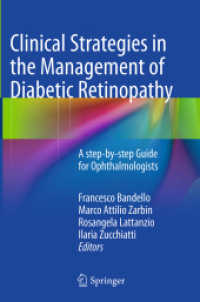- ホーム
- > 洋書
- > 英文書
- > Science / Mathematics
Full Description
Commonly used throughout the world, manual lifting tasks—whether simple or complex—all involve variable loads, postures, and movements. This practical guide discusses how to analyze the intricate lifting function and prevent injury during its execution. Outlining revised NIOSH Lifting Equation (RNLE) methods, the book illustrates their use in assessing manual lifting tasks of varying degrees of difficulty. Using examples to reinforce presented concepts, it explains how RNLE methods can be applied to evaluate single, composite, variable, and sequential lifting tasks. It also explores how to interpret and apply the results according to international standards and guidelines.
Contents
Introduction. A Brief History of the NIOSH Lifting Equation. International Standards on Manual Lifting: ISO 11228-1 and EN 100S-2. Methods and Criteria for Analyzing Manual Handling Tasks. How to Analyze a Single Lifting Task. How to Analyze a Multiple (Composite) Lifting Task (Up to 10 Variants). How to Analyze a Composite Lifting Task When More Than 10 Task Variants Are Present. How to Analyze a Variable Lifting Task. How to Analyze Sequential Lifting Tasks. Mapping Lifting Tasks in a Company. Reference to Available Software and Instructions for Use. Active Health Surveillance of Workers: Procedures and Clinical Tools.







